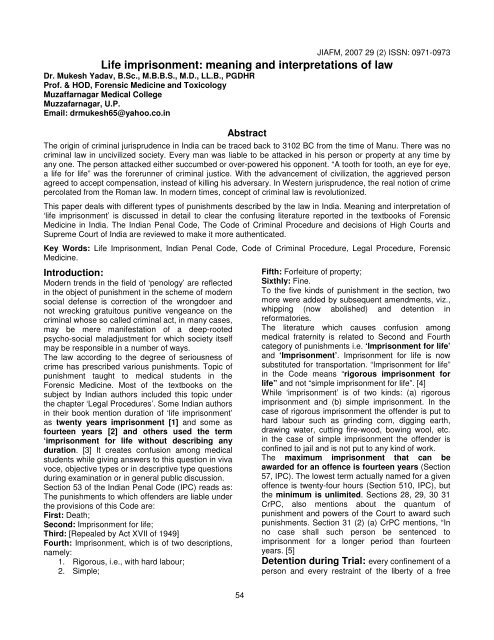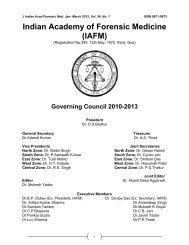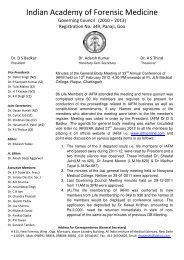Journal of Indian Academy of Forensic Medicine (JIAFM)
Journal of Indian Academy of Forensic Medicine (JIAFM)
Journal of Indian Academy of Forensic Medicine (JIAFM)
You also want an ePaper? Increase the reach of your titles
YUMPU automatically turns print PDFs into web optimized ePapers that Google loves.
54<br />
<strong>JIAFM</strong>, 2007 29 (2) ISSN: 0971-0973<br />
Life imprisonment: meaning and interpretations <strong>of</strong> law<br />
Dr. Mukesh Yadav, B.Sc., M.B.B.S., M.D., LL.B., PGDHR<br />
Pr<strong>of</strong>. & HOD, <strong>Forensic</strong> <strong>Medicine</strong> and Toxicology<br />
Muzaffarnagar Medical College<br />
Muzzafarnagar, U.P.<br />
Email: drmukesh65@yahoo.co.in<br />
Abstract<br />
The origin <strong>of</strong> criminal jurisprudence in India can be traced back to 3102 BC from the time <strong>of</strong> Manu. There was no<br />
criminal law in uncivilized society. Every man was liable to be attacked in his person or property at any time by<br />
any one. The person attacked either succumbed or over-powered his opponent. “A tooth for tooth, an eye for eye,<br />
a life for life” was the forerunner <strong>of</strong> criminal justice. With the advancement <strong>of</strong> civilization, the aggrieved person<br />
agreed to accept compensation, instead <strong>of</strong> killing his adversary. In Western jurisprudence, the real notion <strong>of</strong> crime<br />
percolated from the Roman law. In modern times, concept <strong>of</strong> criminal law is revolutionized.<br />
This paper deals with different types <strong>of</strong> punishments described by the law in India. Meaning and interpretation <strong>of</strong><br />
‘life imprisonment’ is discussed in detail to clear the confusing literature reported in the textbooks <strong>of</strong> <strong>Forensic</strong><br />
<strong>Medicine</strong> in India. The <strong>Indian</strong> Penal Code, The Code <strong>of</strong> Criminal Procedure and decisions <strong>of</strong> High Courts and<br />
Supreme Court <strong>of</strong> India are reviewed to make it more authenticated.<br />
Key Words: Life Imprisonment, <strong>Indian</strong> Penal Code, Code <strong>of</strong> Criminal Procedure, Legal Procedure, <strong>Forensic</strong><br />
<strong>Medicine</strong>.<br />
Introduction:<br />
Modern trends in the field <strong>of</strong> ‘penology’ are reflected<br />
in the object <strong>of</strong> punishment in the scheme <strong>of</strong> modern<br />
social defense is correction <strong>of</strong> the wrongdoer and<br />
not wrecking gratuitous punitive vengeance on the<br />
criminal whose so called criminal act, in many cases,<br />
may be mere manifestation <strong>of</strong> a deep-rooted<br />
psycho-social maladjustment for which society itself<br />
may be responsible in a number <strong>of</strong> ways.<br />
The law according to the degree <strong>of</strong> seriousness <strong>of</strong><br />
crime has prescribed various punishments. Topic <strong>of</strong><br />
punishment taught to medical students in the<br />
<strong>Forensic</strong> <strong>Medicine</strong>. Most <strong>of</strong> the textbooks on the<br />
subject by <strong>Indian</strong> authors included this topic under<br />
the chapter ‘Legal Procedures’. Some <strong>Indian</strong> authors<br />
in their book mention duration <strong>of</strong> ‘life imprisonment’<br />
as twenty years imprisonment [1] and some as<br />
fourteen years [2] and others used the term<br />
‘imprisonment for life without describing any<br />
duration. [3] It creates confusion among medical<br />
students while giving answers to this question in viva<br />
voce, objective types or in descriptive type questions<br />
during examination or in general public discussion.<br />
Section 53 <strong>of</strong> the <strong>Indian</strong> Penal Code (IPC) reads as:<br />
The punishments to which <strong>of</strong>fenders are liable under<br />
the provisions <strong>of</strong> this Code are:<br />
First: Death;<br />
Second: Imprisonment for life;<br />
Third: [Repealed by Act XVII <strong>of</strong> 1949]<br />
Fourth: Imprisonment, which is <strong>of</strong> two descriptions,<br />
namely:<br />
1. Rigorous, i.e., with hard labour;<br />
2. Simple;<br />
Fifth: Forfeiture <strong>of</strong> property;<br />
Sixthly: Fine.<br />
To the five kinds <strong>of</strong> punishment in the section, two<br />
more were added by subsequent amendments, viz.,<br />
whipping (now abolished) and detention in<br />
reformatories.<br />
The literature which causes confusion among<br />
medical fraternity is related to Second and Fourth<br />
category <strong>of</strong> punishments i.e. ‘Imprisonment for life’<br />
and ‘Imprisonment’. Imprisonment for life is now<br />
substituted for transportation. “Imprisonment for life”<br />
in the Code means “rigorous imprisonment for<br />
life” and not “simple imprisonment for life”. [4]<br />
While ‘imprisonment’ is <strong>of</strong> two kinds: (a) rigorous<br />
imprisonment and (b) simple imprisonment. In the<br />
case <strong>of</strong> rigorous imprisonment the <strong>of</strong>fender is put to<br />
hard labour such as grinding corn, digging earth,<br />
drawing water, cutting fire-wood, bowing wool, etc.<br />
in the case <strong>of</strong> simple imprisonment the <strong>of</strong>fender is<br />
confined to jail and is not put to any kind <strong>of</strong> work.<br />
The maximum imprisonment that can be<br />
awarded for an <strong>of</strong>fence is fourteen years (Section<br />
57, IPC). The lowest term actually named for a given<br />
<strong>of</strong>fence is twenty-four hours (Section 510, IPC), but<br />
the minimum is unlimited. Sections 28, 29, 30 31<br />
CrPC, also mentions about the quantum <strong>of</strong><br />
punishment and powers <strong>of</strong> the Court to award such<br />
punishments. Section 31 (2) (a) CrPC mentions, “In<br />
no case shall such person be sentenced to<br />
imprisonment for a longer period than fourteen<br />
years. [5]<br />
Detention during Trial: every confinement <strong>of</strong> a<br />
person and every restraint <strong>of</strong> the liberty <strong>of</strong> a free









